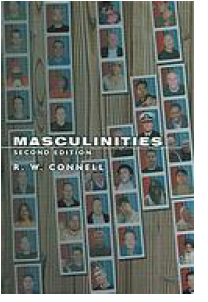R. W. Connell is a professor of education at the University of Sydney, Australia. Here, she analyses the challenges and difficulties of the modern male gender role:

To argue for degendering is to revisit an old feminist debate over equality and difference. It was successfully argued in the late 1970s that a degendering strategy of equality undermined women rather than affirming them, because it demanded they become like men; equality meant sameness, and women’s culture would be lost. A strategy based from the start on a critique of masculinity … faces a related [difficulty]. Abolishing hegemonic masculinity risks abolishing, along with the violence and hatred, the positive culture produced around hegemonic masculinity …
[T]o recognize the diversity in masculinities is not enough. We must also recognize the relations between the different kinds of masculinity: relations of alliance, dominance and subordination. These relationships are constructed through practices that exclude and include, that intimidate, exploit and so on. There is gender politics within masculinity. School studies show patterns of hegemony vividly. In certain schools the masculinity exalted through competitive sport is hegemonic; this means that sporting prowess is a test of masculinity even for boys who detest the locker room …
Homophobia is not just an attitude. Straight men’s hostility to gay men involves real social practice, ranging from job discrimination through media vilification to imprisonment and sometimes murder … The point of these practices is not just to abuse individuals. It is also to draw social boundaries, defining ‘real’ masculinity by its distance from the rejected … In the homophobic ideology the boundary between masculine and feminine, gay men being imagined as feminized men and lesbians as masculinized women. Yet gay men also know the prevalence of homosexual desire among the apparently highly masculine (the gay jock, the warder who rapes, the army ‘buddies’) … Styles in the gay communities of Western cities have shifted from camp to butch, and may be shifting again with queer. Gay men’s collective knowledge, thus, includes gender ambiguity, tension between bodies and identities, and contradictions in and around masculinity … Not drag queens but ‘Castro Street clones’, equipped with jeans and T-shirts, moustaches and cropped hair, became the international leaders of style in gay communities in the later 1970s. The diversification of sexual scenes brought leather, SM and rough trade to a greater prominence. There may have been, as some argue, an element of parody in gay men’s adoption of hyper-masculine styles. But there is little doubt about the cultural shift away from femininity …
Plainly a gay community does not automatically generate an oppositional masculinity politics. Yet the presence of a stable alternative to hegemonic masculinity—the irreversible achievement of the last quarter-century—reconfigures the politics of masculinity as a whole, making gender dissidence a permanent possibility.
Connell, R.W. 2005. Masculinities. Sydney: Allen and Unwin. pp. 26, 233, 37, 40, 218, 219. || Amazon || WorldCat
